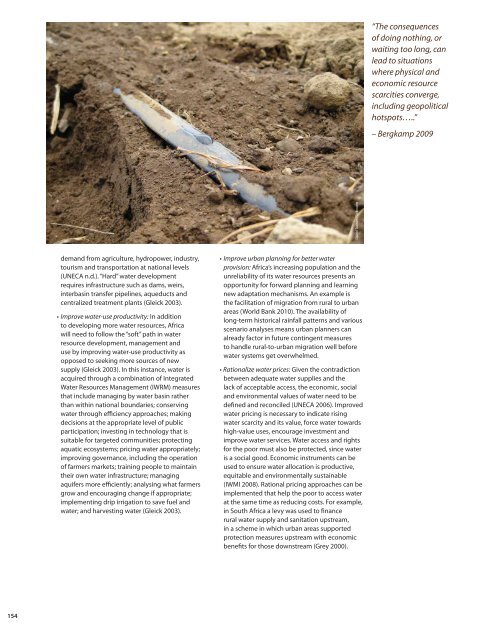Africa Water Atlas - UNEP/GRID-Sioux Falls
Africa Water Atlas - UNEP/GRID-Sioux Falls
Africa Water Atlas - UNEP/GRID-Sioux Falls
Create successful ePaper yourself
Turn your PDF publications into a flip-book with our unique Google optimized e-Paper software.
“The consequences<br />
of doing nothing, or<br />
waiting too long, can<br />
lead to situations<br />
where physical and<br />
economic resource<br />
scarcities converge,<br />
including geopolitical<br />
hotspots…..”<br />
– Bergkamp 2009<br />
David Trainer/Flickr.com<br />
demand from agriculture, hydropower, industry,<br />
tourism and transportation at national levels<br />
(UNECA n.d.). “Hard” water development<br />
requires infrastructure such as dams, weirs,<br />
interbasin transfer pipelines, aqueducts and<br />
centralized treatment plants (Gleick 2003).<br />
• Improve water-use productivity: In addition<br />
to developing more water resources, <strong>Africa</strong><br />
will need to follow the “soft” path in water<br />
resource development, management and<br />
use by improving water-use productivity as<br />
opposed to seeking more sources of new<br />
supply (Gleick 2003). In this instance, water is<br />
acquired through a combination of Integrated<br />
<strong>Water</strong> Resources Management (IWRM) measures<br />
that include managing by water basin rather<br />
than within national boundaries; conserving<br />
water through efficiency approaches; making<br />
decisions at the appropriate level of public<br />
participation; investing in technology that is<br />
suitable for targeted communities; protecting<br />
aquatic ecosystems; pricing water appropriately;<br />
improving governance, including the operation<br />
of farmers markets; training people to maintain<br />
their own water infrastructure; managing<br />
aquifers more efficiently; analysing what farmers<br />
grow and encouraging change if appropriate;<br />
implementing drip irrigation to save fuel and<br />
water; and harvesting water (Gleick 2003).<br />
• Improve urban planning for better water<br />
provision: <strong>Africa</strong>’s increasing population and the<br />
unreliability of its water resources presents an<br />
opportunity for forward planning and learning<br />
new adaptation mechanisms. An example is<br />
the facilitation of migration from rural to urban<br />
areas (World Bank 2010). The availability of<br />
long-term historical rainfall patterns and various<br />
scenario analyses means urban planners can<br />
already factor in future contingent measures<br />
to handle rural-to-urban migration well before<br />
water systems get overwhelmed.<br />
• Rationalize water prices: Given the contradiction<br />
between adequate water supplies and the<br />
lack of acceptable access, the economic, social<br />
and environmental values of water need to be<br />
defined and reconciled (UNECA 2006). Improved<br />
water pricing is necessary to indicate rising<br />
water scarcity and its value, force water towards<br />
high-value uses, encourage investment and<br />
improve water services. <strong>Water</strong> access and rights<br />
for the poor must also be protected, since water<br />
is a social good. Economic instruments can be<br />
used to ensure water allocation is productive,<br />
equitable and environmentally sustainable<br />
(IWMI 2008). Rational pricing approaches can be<br />
implemented that help the poor to access water<br />
at the same time as reducing costs. For example,<br />
in South <strong>Africa</strong> a levy was used to finance<br />
rural water supply and sanitation upstream,<br />
in a scheme in which urban areas supported<br />
protection measures upstream with economic<br />
benefits for those downstream (Grey 2000).<br />
154
















